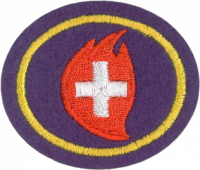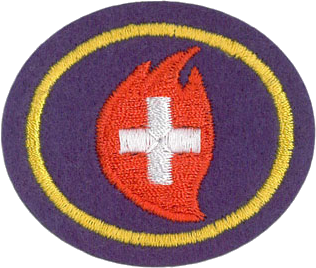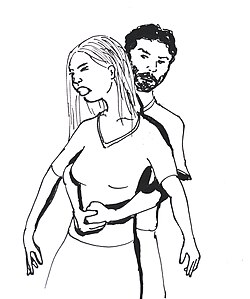AY Honor Red Alert Answer Key
1
1a
If possible, and only if you can do it safely-locate the fire. Remember to stay calm. Alert any other people that are in the building, preferably by pulling the nearest fire alarm (when in a public building). If the fire is small and a fire extinguisher is handy, an attempt to put the fire out should be made. If the fire is already large, or you fail to extinguish it, you must evacuate the building as safely and as quickly as possible. Keep in mind that fires can spread very quickly so it is better to err on the side of caution by getting the fire department started before the fire is out of control.
Feel any door before opening it, and if it is hot, do not open it. Try to exit the building without going through an area that is in flames, then stop, drop, and crawl. Call the fire department.
1b
- Blizzard
- In a blizzard, make sure the doors are closed and all windows are up. Use water a little at a time and shut off the car's engine to prevent carbon monoxide poisoning. When the snow stops, get out of the car and clear the snow off the roof, hood, trunk, and windows. This will allow others to see the car and will allow sunlight to warm the inside.
- Desert
- Get out of the car and find shade. If necessary, take shelter in the shadow of your car. Try to stay hydrated by drinking water. If you run out of water you may be able to collect it off the car in the morning when the dew falls. Rather than rationing your water, drink all you can when you can. Rather than shedding your clothing, put more on to hold in your body's moisture. Stay near the car. Do not try to hike to the gas station you think you passed "two miles ago." It could easily have been 10 miles ago.
1c
Contact the police and stay calm. Stay out of traffic. If your car is in the traffic lanes try to move it or get everyone out of the car and away from traffic to prevent injury if the disabled car is hit again. If available, light road flares to alert other motorists of the danger ahead.
1d
Go somewhere safe such as under a heavy table or desk or stand in a doorway and away from windows, breakable and objects. Stay calm. If you are outside, stay away from buildings and power lines. Once the shaking stops, exit the building and stay outside until the building judged safe by a responsible adult (minor earthquake) or building inspector (major damage). Be aware aftershocks commonly follow earthquakes so don't assume the danger is over just because the shaking stopped.
Earthquakes cause other dangers, some of which may not be immediately obvious. Broken gas mains can cause explosions. Electricity may be disabled. Live powerlines may fall down. Traffic accidents may increase due to panic and damaged infrastructure. Roads and bridges may be damaged and unsafe. Local flooding can happen because of failed water mains or broken dams. In coastal areas you may need to evacuate to higher ground to escape an earthquake caused tsunamis.
Emergency services may be overwhelmed so only call 911 if you have a serious problem requiring immediate emergency attention. Cell phone networks may be damaged, and are likely to overload from excessive use following an earthquake. Do your part to limit phone calls and cell phone internet use to absolutely necessary communication. Consider a text or facebook post to advise loved ones you are ok rather than adding to the network burden.
Consider knocking on doors to check on neighbours. Local radio is the best source of information following a major earthquake because it is available in automobiles and radio stations are specifically designated to quickly share important information in major emergencies.
1e
Learn the safest route to travel, staying on higher ground away from low-lying areas. Disconnect electrical appliances and equipment, or turn off the main breaker. Know public warning in your area. Do not attempt to cross a flooded stream, such as one that is over the road. Water is very strong and can sweep even a heavy truck downstream in an instant. If you find yourself being swept downstream, try to float on your back and get your feet in front of you with your toes out of the water to avoid foot-entrapment. Do not try to stand in swift water, as if you are knocked over and your foot becomes entrapped by something under the water, the water will hold you down and you will not be able to get up. Use your arms to keep yourself afloat and to guide yourself to the bank.
1f
Go to a basement or storm shelter. Remain alert to weather conditions. Be familiar with the community warning systems.
1g
When a hurricane is forecast to strike your area, take steps to protect yourself. Put up shutters to protect your property and evacuate if advised to do so by local officials. Have a supply of non-perishable food and water on hand. Be aware of storm surge, which is caused when a hurricane temporarily raises the level of the ocean, sometimes by dozens of feet. Take shelter somewhere on high ground during the storm.
1h
Stay away from trees, tall objects, water, and objects made of metal (such as railing). If possible, get inside a building or in a car. If your hair stands on end, drop to your knees and place your hands on your knees. This will make you a smaller target for a lightning strike. Do not lay on the ground, as this will make you a larger target.
Do not use a traditional land-line telephone (cell phones are OK though). Stay away from windows. Do not take a shower or a bath during a thunderstorm.
1i
You will first need to decide if you should evacuate or take shelter. If the emergency is already underway, you will need to take shelter underground. If the emergency is pending, but likely, you should evacuate to a safe area without delay. Television and radio reports as well as the local law enforcement should be able to help you make this decision.
On an individual scale, one means of preparation for exposure to nuclear fallout is to obtain potassium iodide (KI) tablets as a safety measure to protect the human thyroid gland from the uptake of dangerous radioactive iodine. Another measure is to cover the nose, mouth and eyes with a piece of cloth and sunglasses to protect against alpha particles.
1j
- Rock Avalanche
- Quickly exit the affected area. If escape is not possible, curl into a tight ball facing downhill (with your back to the oncoming rocks) and cover your head. When the landslide ends, check for trapped or injured persons without entering the slide area (more debris could follow). Direct rescue personnel to any victims you are able to locate. Watch for flooding - landslides are usually triggered by water. Watch for broken utility lines (electric, gas, and water) and report them to the authorities.
- Snow
- It is better to not travel in avalanche country, but if travel is necessary, risk can be reduced by observing avalanche safety rules and carrying proper equipment. This includes a radio beacon on every member of your party, and shovels. Radio beacons made for this purpose transmit constantly, and can be switched to receiver mode after an avalanche. These can help to find buried victims. Finding victims quickly and digging them out greatly increases their chances of survival. Avalanche snow compacts into a very hard mass very quickly after an avalanche, so a shovel is an essential piece of gear. It is next to impossible to dig someone out of an avalanche with bare hands or even with a ski, but if that is all you have available, you should start right away.
1k
Get as much of your body out of the water as quickly as possible. Get back to the boat immediately. If possible, right the boat, climb in, and bail it out. Otherwise, stay with the boat, as this will make it easier for a rescuer to find you. Do not attempt to swim to shore, as it is often a lot farther away than it appears.
2
Give your name, phone number, the nature of emergency, the location of the emergency, and whether any personal dangers or injuries are present. To make sure the police correctly attach you (and not someone else with a similar name) to the report you should also provide your birthdate and home address once the more important information is provided.
The person making the call to report an emergency should be the last to hang up the telephone. If you ever call 911 by accident do not hang up. Stay on the line and explain your mistake. Otherwise the police will send out a response you do not need, which could endanger others as emergency vehicles rush to your non-emergency.
3
3a
Get the person to the ground and roll him over and over on the ground. Another option is to wrap the victim with a blanket, coat, or jacket if one is handy. If your own clothes catch on fire, stop, drop, and roll - do the same thing to yourself as you would to someone else.
3b
If you see a person who is bleeding heavily, you can do the following:
- Press hard onto the wound to stop the bleeding.
- If an arm or leg is cut, elevate the limb.
- Cover with a clean pad and apply a bandage.
- Check that the bleeding has stopped. If it has not, add another pad, and bandage, do not remove previous bandage.
- If you have bandaged a limb, check frequently that the fingers and toes remain warm. If fingers and toes are getting cold, loosen the bandage to let the blood circulate.
- For severe bleeding (5 cups of blood or more), get the person to a hospital for stitches (and possibly immunization against Tetanus) keeping the limb raised.
3c
Coughing is the body's natural defense against choking, and it is generally very effective. If the victim is coughing, do not interfere. If the victim stops coughing (or was never coughing in the first place), ask her "are you choking?" If the victim indicates that she is choking, tell her you are going to help her. To do this, you will need to perform the Heimlich Maneuver.
Briefly, a person performing the Heimlich Maneuver uses their hands to exert pressure on the bottom of the diaphragm. This compresses the lungs and exerts pressure on any object lodged in the trachea, hopefully expelling it. This amounts to an artificial cough. (The victim of an obstructed airway, having lost the ability to draw air into the lungs, has lost the ability to cough on their own.)
Even when performed correctly, the Heimlich Maneuver can injure the person it is performed on. The Heimlich Maneuver should never be performed on someone who can still cough, breathe, or speak. It should not be demonstrated or practiced on a healthy, non-choking person.
3d
With poison container in hand, call the local poison control center and do NOT try to make the patient vomit. Only induce vomiting if a poison center worker or a doctor advises you to do so. If the poison is on the skin or clothes, remove the clothing and wash with a large amount of water. If poison gets in the eyes, flush the eyes with clean water for 10 minutes.
Get the victim to a hospital as soon as possible, and if possible, bring the poison container with you.
4
4a
Start by making a map of your house. Draw at least two escape routes for every room, making sure that the two routes do not cross a common area - otherwise, if the common area is affected you will not have a workable escape route.
4b
Arrange this with your family ahead of time. Choose a meeting place well away from the house so that if a real fire occurs, everyone will know to go there, and if anyone is missing, it can be assumed that they are still in the house. Go over the escape routes with everyone.
4c
Panic usually occurs because a person does not know how to react in a dangerous situation. Having a plan in place before an emergency occurs will help control panic. Practicing the plan ahead of time (such as with a fire drill) reinforces the plan in everyone's minds, so that the situation will feel more familiar if it really happens. Rather than thinking "Oh no! What do I do?!" a practiced person will think "Oh, yes. I know what to do."
If you find yourself in an emergency and feel yourself beginning to panic, try to calm down and use your head. Panic will only make things worse. If you see others beginning to panic, touch them, tell them to calm down, and tell them exactly what they should do. If they see that you are not in a panic and seem to know what to do, they will likely follow.
The best way to quickly evacuate a crowded building such as a church or a school is for everyone to calmly walk out in an orderly fashion. If everyone runs, panic is more likely to take over, and the exits will become jammed as people attempt to squeeze around one another. People have been killed by crowds stampeding out of a building in a panic.
5
Know where your children are all the time. Never leave children alone in cars. Establish a family code word. Tell the children never to go with anyone who does not know the code word. Have fingerprints taken of your children. Keep current photos and records (dental/medical). Make mental note of what your child wears every day. Make sure your children know their address and telephone number, and how to use the telephone. Teach them how to dial 9-1-1.
What to do if abducted: Yell - This person is not my father/mother. Kick the kidnapper's foot or knee. Scream "Fire!" as this is more likely to attract attention than screaming "Help!"
References
Wikipedia references:
Other references:



